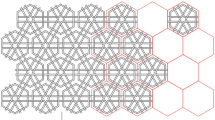Abstract
The purpose of this paper is to develop the Islamic geometric patterns from planar coordinates to three or higher dimensions through their repeat units. We use historical plane methods, polygons in contact (PIC) and point-joined, in our deductive approaches. The mentioned approach makes use of a novel method of tessellation that generates 3D Islamic patterns called “interior polyhedral stellations”. The outputs showed that both the PIC and point-joined methods have strengths and weaknesses. Point-joined stellations are more efficient for regular repeat units and PIC is suitable for complex designs. These two methods can produce a large range of patterns and can be employed simultaneously. This study effectively answers the question regarding the gap between planar design from Muslim achievements and contemporary demands in modern art and architecture. We also propose techniques for constructing aperiodic three-dimension Islamic geometric patterns tessellation and two-point family.
















Similar content being viewed by others
References
Abas, Syed Jan, and Amer Shaker Salman. 1995. Symmetries of Islamic geometrical patterns. World Scientific.
Bloom, Jonathan M. 1987. The introduction of the muqarnas into Egypt. Muqarnas Online 5 (1):21-28
Bonner, Jay. 2003. Three Traditions of Self-Similarity in Fourteenth and Fifteenth Century Islamic Geometric Ornament. In Meeting Alhambra, ISAMA-BRIDGES Conference Proceedings. Granada, Spain: University of Granada.
Bonner, Jay. 2017a. 2 Differentiation: Geometric Diversity and Design Classification. In Islamic Geometric Patterns, 153–220. New York, NY: Springer.
Bonner, Jay. 2017b. Islamic geometric patterns: their historical development and traditional methods of construction. New York: Springer.
Bonner, Jay. 2018. Doing the Jitterbug with Islamic geometric patterns. Journal of Mathematics and the Arts 12 (2-3):128-143. doi:https://doi.org/10.1080/17513472.2018.1466431.
Bonner, Jay, and Craig S Kaplan. 2017. 4 Computer Algorithms for Star Pattern Construction. In Islamic Geometric Patterns, 549–573. New York, NY: Springer.
Broug, Eric. 2008. Islamic geometric patterns. Thames & Hudson London.
Broug, Eric. 2013. Islamic geometric design. Thames & Hudson.
Cajori, Florian. 1926. Origins of fourth dimension concepts. The American Mathematical Monthly 33 (8):397-406.
Castera, Jean-Marc. 2016. Persian variations. Nexus Network Journal 18 (1):223-274.
Coxeter, Harold Scott Macdonald. 1973. Regular polytopes. Courier Corporation.
Cromwell, Peter R. 1999. Polyhedra. Cambridge University Press.
Cromwell, Peter R. 2009. The Search for Quasi-Periodicity in Islamic 5-fold Ornament. The Mathematical Intelligencer 31 (1):36-56. doi:https://doi.org/10.1007/s00283-008-9018-6.
Danzer, L. 1995. A family of 3D-spacefillers not permitting any periodic or quasiperiodic tiling: World Scientific: Singapore.
Dunham, Douglas. 2001. Hyperbolic islamic patterns–a beginning. Bridges:247–254.
Escher, Maurits Cornelis. 2000. MC Escher: the graphic work. Taschen.
Firby, Peter A, and Cyril F Gardiner. 2001. Surface topology. Elsevier.
Gardner, Martin. 1971. Sixth book of mathematical games from Scientific American. WH Freeman.
Gardner, Martin. 1977. Extraordinary nonperiodic tiling that enriches the theory of tiles. Scientific American 236 (1):110-121.
Grünbaum, B., and G. C. Shephard. 1987. Tilings and patterns. New York: WH Freeman & co.
Grünbaum, Branko. 1994. Uniform tilings of 3-space. Geombinatorics 4 (2):49-56.
Hankin, E. Hanbury. 1925. The drawing of geometric patterns in Saracenic art. Calcutta: Govt. of India Central Publication Branch.
Hofstadter, Douglas. 2008. Metamagical themas: Questing for the essence of mind and pattern. Basic books.
Horne, Clare E. 2000. Geometric symmetry in patterns and tilings. Woodhead Publishing.
Johnson, Norman W. 1966. Convex polyhedra with regular faces. Canadian Journal of mathematics 18:169-200.
Kaplan, Craig S. 2005. Islamic star patterns from polygons in contact. In Proceedings of Graphics Interface 2005: Canadian Human-Computer Communications Society.
Kaplan, Craig S. 2000. Computer generated islamic star patterns. Bridges:105–112.
Kaplan, Craig S. 2003. Taprats. Computer-generated Islamic star patterns. https://www.cgl.uwaterloo.ca/csk/washington/taprats/.
Kaplan, Craig S., and David H. Salesin. 2004. Islamic star patterns in absolute geometry. ACM Transactions on Graphics (TOG) 23 (2):97-119.
Lu, Peter J., and Paul J. Steinhardt. 2007. Decagonal and quasi-crystalline tilings in medieval Islamic architecture. Science (New York, N.Y.) 315 (5815):1106–1110. doi:10.1126/science.1135491.
Makovicky, Emil. 1992. 800-Year-Old Pentagonal Tiling From Marāgha, Iran, And The New Varieties Of Aperiodic Tiling It Inspired, 67–86. World Scientific.
McLaren-Young-Sommerville, Duncan. 1958. An Introduction to the Geometry of n Dimensions.
Mohammadi, Amir Amjad, Maziar Asefi, and Ahad Nejad Ebrahimi. 2018. The geometrical regularization for covering irregular bases with Karbandi. Nexus Network Journal 20 (2):331-352.
Necipoğlu, Gülru. 2017. The Arts of Ornamental Geometry. Brill.
Necipoğlu, Gülru, and Karen Leal. 2010. Muqarnas. Brill.
Özdural, Alpay. 2000. Mathematics and Arts: Connections between Theory and Practice in the Medieval Islamic World. Historia Mathematica 27 (2):171-201. doi:https://doi.org/10.1006/hmat.1999.2274.
Palmer, Ross. 2011. 10 The Masdar Institute’s GRC Residential Facade.
Patterns | School of Islamic Geometric Design. https://www.sigd.org/resources/pattern/. Accessed.
Reitebuch, Ulrich, Henriette-Sophie Lipschütz, and Konrad Polthier. 2018. Girih Tiles in 3D. In Bridges 2018 Conference Proceedings: Tessellations Publishing.
Riether, Gernot, and Daniel Baerlecken. 2012. Digital Girih, a digital interpretation of Islamic architecture. International Journal of Architectural Computing 10 (1):1-11.
Schattschneider, Doris. 1990. Visions of symmetry: Notebooks, periodic drawings, and related work of MC Escher. WH Freeman New York.
Senechal, Marjorie. 1996. Quasicrystals and geometry. CUP Archive.
Sherk, F Arthur, Peter McMullen, Anthony C Thompson, and Asia Ivic Weiss. 1995. Kaleidoscopes: Selected Writings of HSM Coxeter. John Wiley & Sons.
Steinhaus, Hugo. 1999. Mathematical snapshots. Courier Corporation.
Thomas, BG, and MA Hann. 2007. Patterns in the plane and beyond: Symmetry in two and three dimensions. University of Leeds.
Wells, David. 1991. The Penguin dictionary of curious and interesting geometry. Penguin Mass Market.
Wichmann, Brian, and David Wade. 2017. Islamic Design: A mathematical approach. Springer.
Acknowledgements
All the graphical illustrations are done by the authors.
Author information
Authors and Affiliations
Corresponding author
Additional information
Publisher's Note
Springer Nature remains neutral with regard to jurisdictional claims in published maps and institutional affiliations.
Electronic supplementary material
Below is the link to the electronic supplementary material.
About this article
Cite this article
Moradzadeh, S., Nejad Ebrahimi, A. Islamic Geometric Patterns in Higher Dimensions. Nexus Netw J 22, 777–798 (2020). https://doi.org/10.1007/s00004-020-00486-0
Published:
Issue Date:
DOI: https://doi.org/10.1007/s00004-020-00486-0




